Introduction
Distribution
The sample data set and other scripts can be obtained by
downloading Dist.tgz and then unpacking
with the command
gunzip -c Dist.tgz | tar xf -
cd EMPIRICAL_GREEN/DIST
In that folder you will find the following files:
EMPIRICAL_GREEN/DIST/
|--/RANDOM4/
| |--DOIT
| |--MFTDOOVERLAY
| |--PHVDOOVERLAY
| |--DOCLEAN
| |--CUS.mod
|
|--/EXAMPLE1/
| |--DOSRF
| |--MFTDOOVERLAY
| |--PHVDOOVERLAY
| |--DOCLEAN
| |--SIUCBHZBLOBHZ.WSTK
| |--CUS.mod
|
|--/EXAMPLE.GRN/
|--CUS.mod
|--DOIT
|--DOCLEAN
Sac Files
In order to use Sac files that are not created by the Computer
Programs in Seismology codes, one must be careful about the
following header values:
- The O header that sets the origin time must be set
- The DIST header which gives epicentral distance in km must be
defined .
- The USER1 and USER2 headers define the minimum and maximum
periods permitted for processing. If uncertain about these
values, set each to -12345. using the ch command in sac/gsac.
The reason for this specific restriction is that spectral
amplitudes should not be used outside the acceptable bandpass
region.
If in doubt, look at the header values of the sample
cross-correlation in the file SIUCBHZBLOBHZ.WSTK in
EMPIRICAL_GREEN/DIST/EXAMPLE1
Theory
The detailed theory is given in MFT.pdf
(
updated MAY 31, 2021)
Program Usage
This discussion uses the files in the sub-directory
EMPIRICAL_GREEN/DIST/EXAMPLE1. The tutorial on the use
of do_mft is here.
Tests
Simulation of a noise field
The critical relationship for the determination of phase
velocities is the phase correction applied in Equation (6) of the
document MFT.pdf.
Consider the subdirectory EMPIRICAL_GREEN/DIST/RANDOM4.
The DOIT script creates a data set consisting of MAXSRC time
segments, each of which has 20 source events distributed randomly
in a source region 1600 km x 1600 km. Two stations are at
coordinates (-200,0) and (200, 0 ) on this grid. The random
source coordinates and station coordinates in km are converted to
latitude and longitude in order to create a map. For the
demonstration script, the values of these parameters are
MAXSRC=100 and SUBSOURCE takes the vales 00, 01, ..., 19. A larger
value of MAXSRC will yield better results, but the computations
will take longer.
The idea is to create MAXSRC time series, representing the
different noise segments used with real data. Each of this time
series consists of the waveforms or 20 randomly distributed
sources. This approach is use to emulate processing of real noise
data.
The current DOIT script does the following:
- Generates the eigenfunctions and dispersion for the CUS.mod
velocity model for a source depth of 0.01 km.
- For each time segment (from 0 to MAXSRC -1)
- Loop over the subsources, then
- Define the spatial coordinates of the subsource
- Define a random orientation for a point source applied at
the subsource
- Compute fundamental mode Green's functions to each
of the two stations
- Apply the source to create Z, N and E seismograms from the
seismograms for the particular force function
- Store the Z, E and E seismograms in the sub-directories
POS1 and POS2 with a name such as 44.17.Z, which represents
the Z component seismogram for time segment 44 and subsource
17. The POS1 and POS2 contain the individual time histories
at receiver positions 1 and 2.
- Stack the subsource contributions to each seismogram and
store appropriately in the sub-directories STACK1 or STACK2
with a name such as 44.Z, which represents the Z component
seismogram for the time segment 44.
- Cross-correlate the components between the stations and save
the result in sub-directory CORR. For example,
STACK1/44.Z cross-correlated with STACK2/44.Z will result in
CORR/44.Z1Z2. All nine possible cross-correlations are
saved, for example, CORR/44.E1E2, CORR/44.E1Z2,
CORR/44.N1N2, CORR/44.Z1E2,
CORR/44.Z1Z2,
CORR/44.E1N2, CORR/44.N1E2,
CORR/44.N1Z2, and CORR/44.Z1N2.
- After all time segments are processed, the individual
cross-correlations are stacked to form the file Z1Z2, for
example. The reversed time series, Z1Z2.rev is computed
and as the sum of Z1Z2 and Z1Z2.rev which is called Z1Z2.sym,
since it will be symmetric about zero lag. The Z1Z2 and E1E2
will show the Rayleigh wave and the N1N2 will show the Love
wave.
- Finally, the sac files in POS1 and POS2 are read to create a
map.
The question arises as to why this is all done. The
objective is to create a model based synthetic data set that can be
used to mimic the data sets used in the cross-correlation of ground
noise. That processing cross-correlates fixed time windows and
then stacks all of the cross-correlations. The use of the
synthetic data means that the dispersion is known. Thus the group
and phase velocity estimates can be compared to the "true"
values. For this example run (realized that your
runs will use different random number sequences), the local
distribution of sources is shown in the following figure. The yellow
stars indicate the source locations and the red dots indicate the
receiver positions. Sources are not permitted within 50 km of a
receiver to avoid problems with the 1/sqrt(r) geometrical spreading
blowing up.
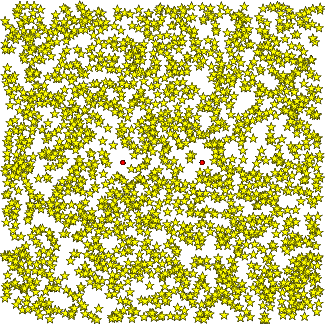
The resulting symmetric traces obtained are
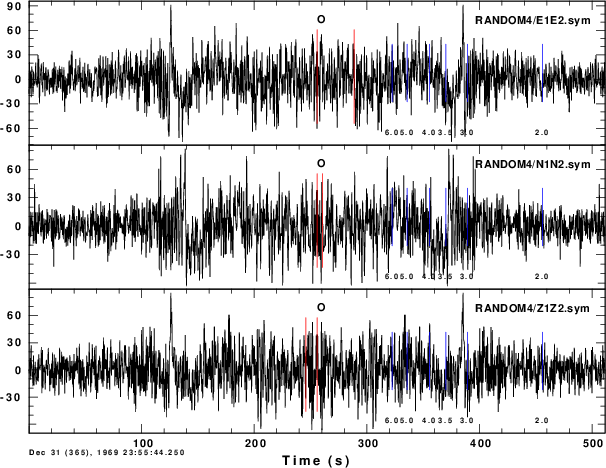
It is seen that there are arrivals with group velocities between 3
and 4 km/s. Since the distributed DOIT script only uses 100
(MAXSRC) time windows, each of which contains the signals of 20
sources, the image will improve if MAXSRC is made larger.
If we now run do_mft in the same directory as the DOIT
script, which is important since we have the enigenfunction files slegn96.egn
and sregn96.egn and also the scripts required by do_mft,
MFTDOOVERLAY and PHVDOOVERLAY to create the
theoretical dispersion plots, the command
do_mft -G -IG -T *.sym
leads to the following comparison plots:
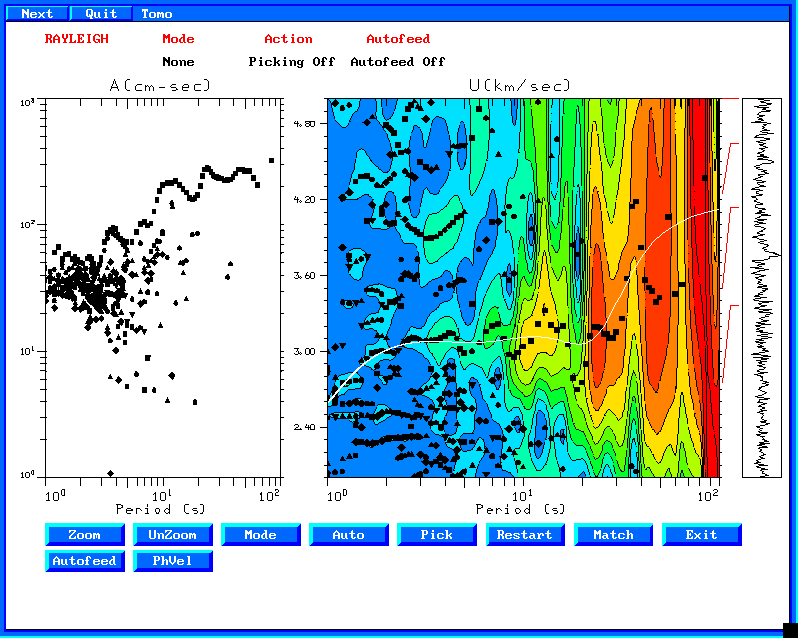
This is the group velocity from the file Z1Z2.sym The white curve is
the model predicted group velocity.
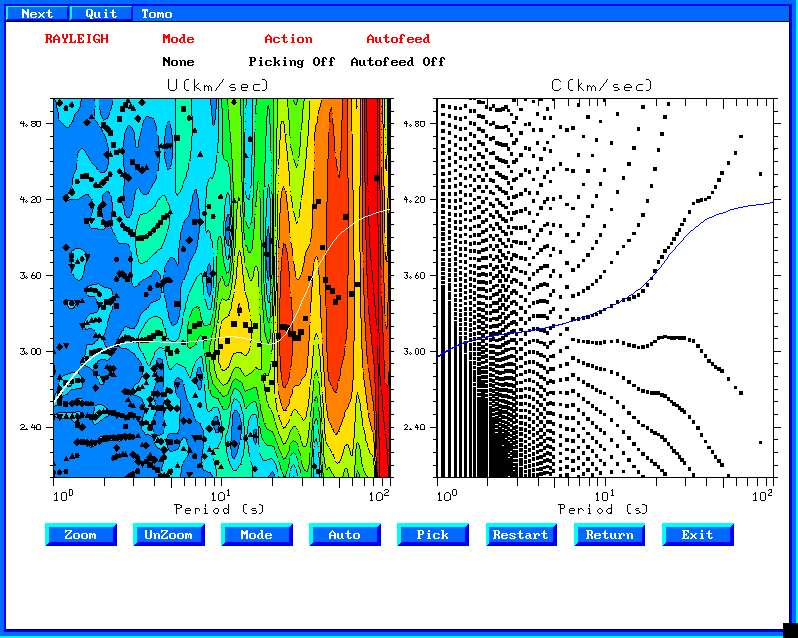
This is the phase velocity panel. Interestingly, there are good
phase velocity estimates despite the poor signal.
The next figures show a run with MAXSRC=2500. The number of
sub-sources for any time window is still 20. The
correspond figures are now
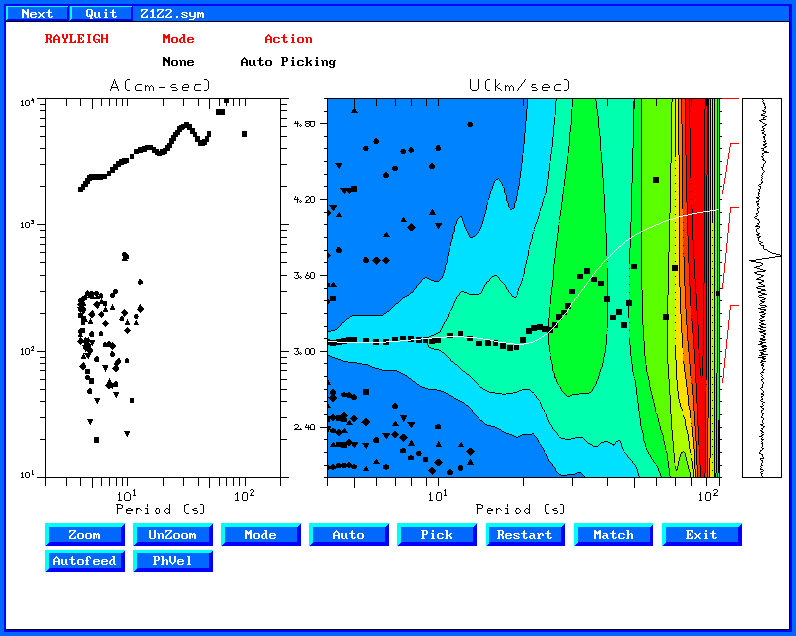
The group velocities are better defined. In addition there is a much
better signal to noise ratio on the stacked Z1Z2.sym trace.
The corresponding phase velocity comparison is shown in the next
figure.
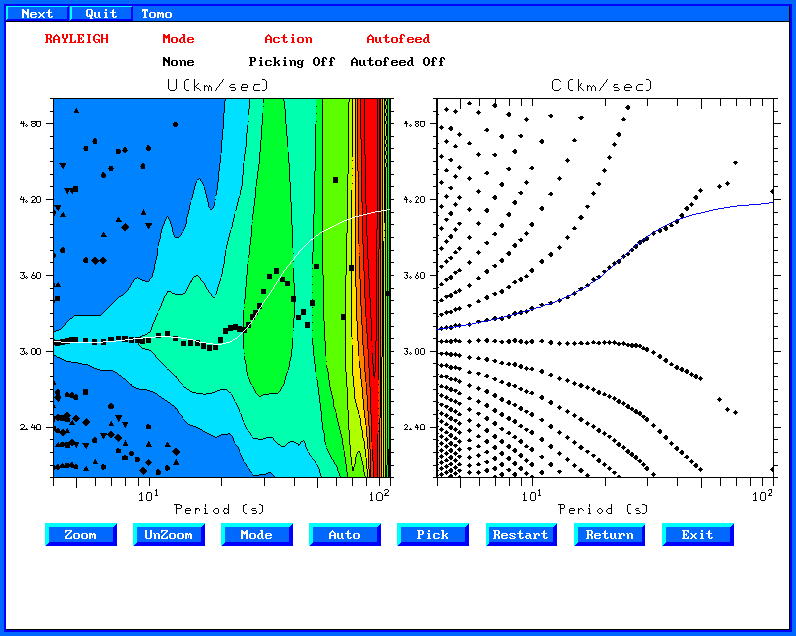
Here there is superb agreement between the theoretical and
experimental phase velocities.
A final set of simulations used MAXSRC=500 and replaced the
distribution of point forces at at depth of 0.1 km by a moment
tensor source at a depth of 10 km, by changing the -HS 0.1 on the
argument of sprep96 to -HS 10, and changing the gsac mt command
syntax to a source with strike 0, dip 80n and rake 10, e.g.,
#mt to ZNE AZ ${AZ2} BAZ ${BAZ2} FN $FN FE $FE FD $FD FILE $B
mt to ZNE AZ ${AZ2} BAZ ${BAZ2} STK 0 DIP 80 RAKE 10 MW 2 FILE $B
Running do_mft with the same arguments, leads to the
following images:
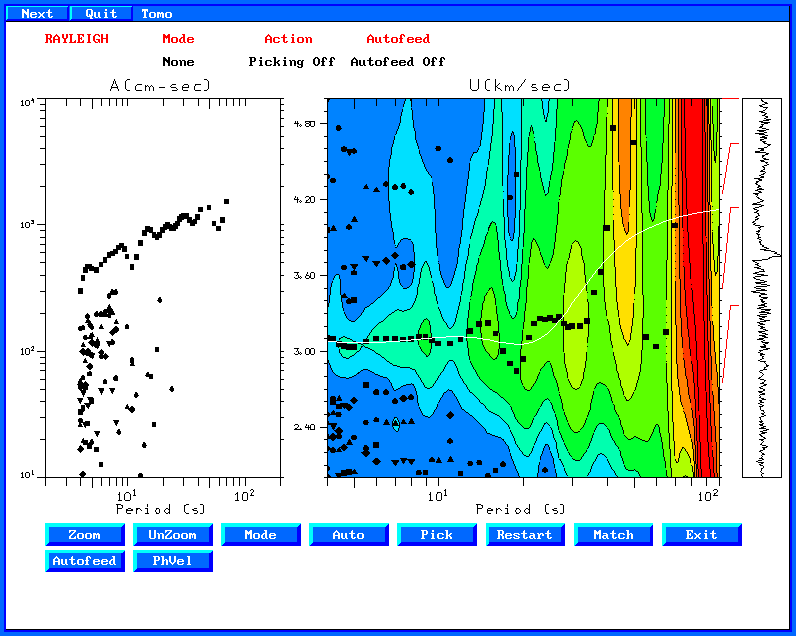
and
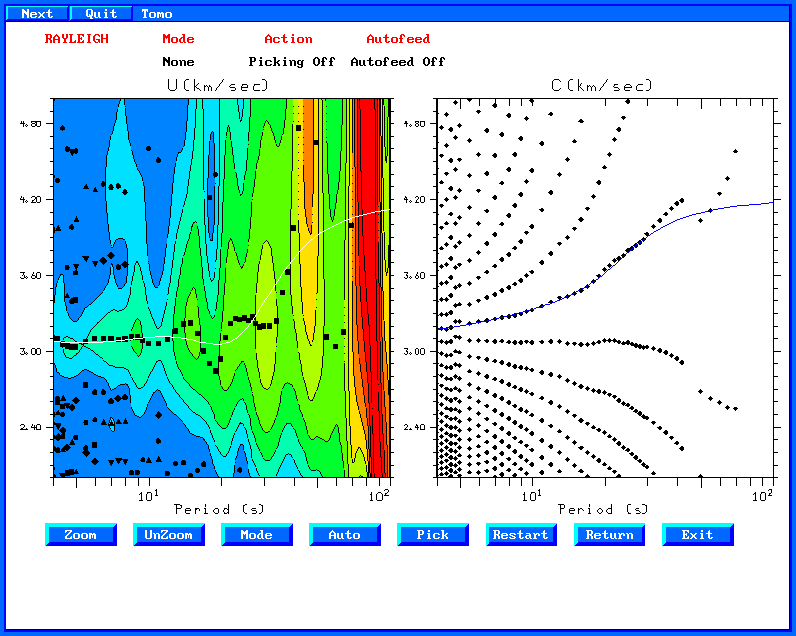
As expected by theory, the distribution of earthquakes sources leads
to the same results.
One should be careful, in that one might be tempted to use the
Z1E2.sym cross-correlation. Theory says that the Rayleigh wave in
the Z1E2 is 90 degrees out of phase with the Z1Z2 time series.
Although both will have the same group velocity, the phase
velocity from Z1E2 will not be correct since do_mft
(sacmft96) does not account for the extra 90 degree phase
difference.
Since the logic behind the scripts works, it is now possible to
consider the effect of less-uniform source distribution on the
stacks and the dispersion analysis.
Other cross-correlations
In running the script for MAXSRC=2500 and 20 subsources
consisting of randomly directed forces, 9 inter-component
cross-correlations can be computed. The previous discussion
focused on the E1E2, N1N2 and Z1Z2. The next figure displays all
nine.
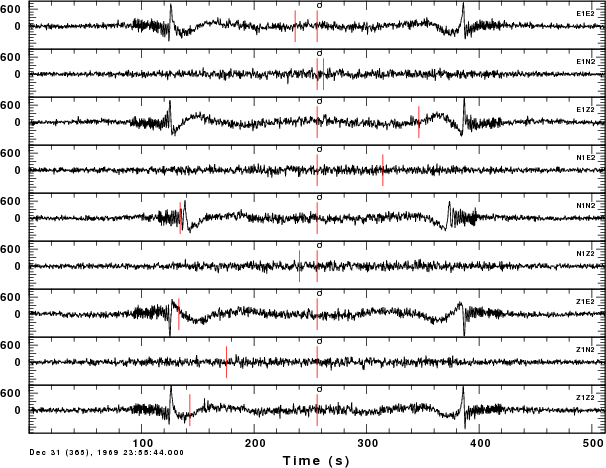
These are displayed with the gsac command ylim all
so that the same amplitude scale is used for each. As
expected for a uniform medium, the Z1N2, N1Z2, N1E2 and E1N2
cross-correlations are very small. From the theoretical
development of Wapenaar (2004), we would expect the Z1N2, for
example, to be related to the wavefield at the second sensor in
the +N direction (negative transverse) due to a point upward
vertical force at the first. Theoretically zero transverse
motion is generated by this symmetric vertical source. The
N1E2, the radial motion generated by a transverse source should
also be zero because of the radiation pattern when the observation
point is in a direction perpendicular ot the direction of the
horizontal force.
Generating the proper synthetic
To test an inverted velocity model, synthetics can be generated
for comparison to the empirical Greens functions. The waveforms
will not be similar because of a different frequency content. Both
can be whitened for comparison and then similarly bandpass
filtered.
Consider the DOIT script in DIST/EXAMPLE.GRN. Green's
functions are computed for the fundamental mode surface wave for a
source depth of 0.01 km and a receiver at the surface. The gsac
command mt is used to make three component synthetics for
a vertical force, Z1Z2 Z1N2 Z1E2, a radially directed horizontal
force, E1Z2 E1N2 E1E2, and a transversely directed force, N1Z2
N1N2 N1E2.
Next given the Z1Z2, etc files in EXAMPLE.GRN and the symmetric
empirical Greens functions in RANDOM4, run the following
commands:
for i in Z1Z2 N1N2 E1E2
do
gsac << EOF
r EXAMPLE.GRN/$i RANDOM4/$i.sym
whiten freqlimits 0.01 0.02 0.25 0.5
w $i.G $i.E
q
EOF
done
#####
# make a plot
#####
gsac << EOF
r E* N* Z*
xlim o 80 o 180
ylim all
fileid name
bg plt
p
q
EOF
plotnps -BGFILL -F7 -W10 -EPS -K < P001.PLT > t.eps
convert -trim t.eps EMPGRN.png
The whiten command with the zero-phase bandpass filter gives the
same amplitude spectrum to both. The resultant plot is
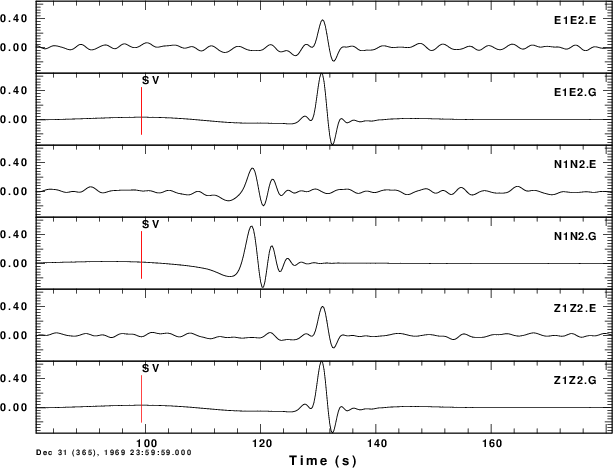 The
The
The .G are from the synthetics and the >E are from the
cross-correlation. The waveform comparison is very good. The
difference in absolute amplitude is no problem.
The demonstrates that synthetics can be generated to mimic the
noise cross-correlation results. This may be valuable to
understand the limitations of the group and phase velocity
analysis, expecially at very short distance.
References
Bensen, G. D., M. H. Ritwoller, M. P. Barmin, A. L. Levshin, F.
Lin, M. P. Moschetti, N. M. Shapiro and Y. Yang (2007). Processing
seismic ambient noise data to obtain reliable broad-band surface
wave dispersion measureements, Geophys. J. Int. 169, 1239-1260.
doi: 10.1111/j.1365-246X.2007.03374.x
Herrmann, R. B. (1973). Some aspects of band-pass filtering of
surface waves, Bull. Seism. Soc. Am. 63, 663-671.
Lin, Fan-Chi and Moschetti, Morgan P. and Ritzwoller, Michael H.
(2008). Surface wave tomography of the western United States from
ambient seismic noise: {Rayleigh} and Love wave phase velocity
maps, Geophys. J. Int. 173, 2810298, doi
10.1111/j.1365-246X.2008.03720.x
Snieder, R. (2004). Extracting the Green's function from the
correlation of coda waves: A derivation based on stationary phase,
Physical. Rev E 69, 046610-1,10
Wapenaar, K. (2004). Retrieving the elastodynamic Green�s
function of an arbitrary inhomogeneous medium by cross
correlation, Phys. Rev. Lettrs. 93, 254301-1 - 254301-4.
last changed November 8, 2013









 The
The